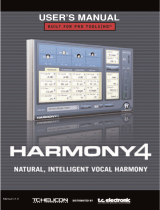
Introduction
VL3X – Reference manual (updated 2015-10-20) 14
Global Effects
VL3X allows you to define a specific Preset as
the “Global” Preset. This defines all of the effects
and parameters within that Preset and allows
them to be easily applied to other Presets.
What does that mean for you? Easier, quick-
er Preset creation and access to consistent
sounds!
Here is an example:
“I want to use this great reverb on a whole bunch
of Presets. How do I do that?”
► First, edit the guitar reverb on your Global Pre-
set (by default, this is Preset no. 491). Editing
guitar settings is explained in greater detail in
“Editing the Guitar Layer”.
► Then go to each Preset where you would like
to use the same Reverb, go to the Reverb
settings and change the Global parameter to
“On”.
Done! This Preset will now use the Reverb set-
tings from the Global Preset.
Setting Global to on links an effect to the
settings defined in the Global Preset
Global effects are available for each and every
effect in the Vocal and Guitar Layers. There are
endless possibilities for Global effects handling,
but here are a couple we think you might like:
Use the same guitar effects
across all Presets
This essentially turns VL3X’s Guitar Layer into a
series of stomp-boxes that you only need to set
up once.
“How do I do that?”
► Simply edit ANY Preset until all of the guitar
effects and footswitch assignments are how
you like them.
► Enter the Setup menu and navigate to the Sys-
tem tab using the horizontal Arrow buttons.
► Dial the Control knob until the line saying “All
Guitar FX Global: Off” is highlighted.
► Turn Mix knob 3 or Mix knob 4 under the dis-
play until “Off” changes to “On”.
Done! Every Preset will now have the same
guitar sounds.
Set All Guitar FX Global to “On” to use the
same guitar effect in all Presets
Make sure a particular effect
always sounds the same
Want a certain Delay available in every Preset?
No problem.
► Just edit the Global Preset’s Delay setting.
► Go to each Preset where you would like to use
the same Delay, go to the Delay settings and
change the Global parameter to “On”.
Always use the same guitar amp model,
but have everything else change
► Easy! Adjust the Global Preset’s Amp setting
the way you want it.
► Go to each Preset where you would like to use
the same Amp, go to the Amp settings and
change the Global parameter to “On”.
Updating Global settings
The Global system is “opt in”. This means each
Preset carries its own individual settings until
you change an effect to Global. Once that hap-
pens, the current Preset and Global Preset set-
tings become shared.
Once you have changed an effect to Glob-
al ON, any edits you make within that Pre-
set affect the Global settings as well. This
means you don’t have to bounce back and forth
between the Global and current Preset to make
changes to Global effects.
It also means that you need to be aware of the
above, so you don’t accidentally edit a Global
setting, thinking you are only editing the current
Preset. With great power comes great respon-
sibility!




















